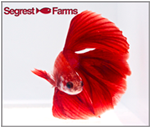
As our access to a world-wide pool of knowledge and information grows, so does our awareness of the global implications of our choices and actions. This has led to an ever increasing focus on sustainability and eco-friendliness. Increasingly, we are needing to examine our impact as consumers as well as our impact as an industry. Unfortunately, there is no easy answer or solution to the problem of being sustainable, but let's take a look at where the ornamental fish industry currently stands, and where it appears to be headed.
The concept of sustainability is an enormously complicated one that can fill numerous books. At its core, sustainability requires a balance of three different variables: environmental, economic, and social. Without these being in balance, it is virtually impossible to achieve sustainability. Every action creates either a positive or a negative environmental impact, but many of these are difficult to predict. The sustainability effort must be economically feasible or you will eventually lose the ability to continue with your effort. Finally, people must believe that it is worth dealing with what are often inconvenient aspects of acting sustainably in order to improve the future of our planet. While this is too much information to look at in one blog post, let's begin by looking at a couple of the issues relating to environmental sustainability.
When looking at environmental sustainability in the ornamental fish industry, there are a couple of different routes that can be taken. The first route is to promote captive bred and farm raised animals, while the second is to work to establish and support sustainable fisheries. Already, the vast majority of freshwater ornamental fish are being supplied from captive raised sources. Here at Segrest Farms, for example, more than 95% of the freshwater fish we offer are captive raised. While the number of marine species being captive raised is still significantly smaller, it is constantly rising as the technology and the understanding of how to successfully breed and raise marine fish improves. For many people, this is the easiest and most direct answer to achieving sustainability in our industry.
The second route to sustainability is through the use of sustainable fisheries. While there are people that argue that taking fish from the wild is going to cause irreparable harm on those natural populations, the reality is that this is not always the case. Already there are sustainable fisheries operating in the Rio Negro in Brazil, in Hawaii, and in Indonesia that we can look at and examine to learn how it is possible for wild collection to benefit those areas.
One reason why sustainable fisheries can work is because of population dynamics. Every habitat has a maximum number of each animal that lives there that it can support, called its carrying capacity, which is influenced by a variety of other factors such as food and shelter. One phenomenon that often happens is that when a population of animals is relatively low compared to its carrying capacity, it will become more reproductively productive. In a sustainable fishery, for example, when a certain number out of a given population of fish are collected, it creates a surplus of food and shelter for the remaining fish who are able to breed and grow faster, replenishing the population back to its carrying capacity. Of course, care must be taken not to remove too many fish from a given population, but when done appropriately, any negative impact disappears.
In many places, there is also a major benefit to creating a sustainable fishery. The same places where ornamental fish are often found are also frequently areas that would be prime targets for other, more destructive industries such as logging, mining, and even food fishing, and many of these areas are in highly remote areas with few other opportunities. By setting up successful sustainable ornamental fisheries, you give the local populations an economic incentive to protect the lands they live and work. Without being able to make this living, many would have no choice but to turn to more destructive means.
As with most difficult problems, there is no solution that only utilizes one method of ensuring the sustainability of the ornamental fish trade. Captive breeding is a powerful tool to utilize, and we must continue supporting efforts to expand our capabilities in this area. There have been a number of exciting breakthroughs recently, including the recent announcement of the longest yet surviving Yellow Tang larvae as well as advancements in several new marine angels and butterflyfish. However, we must pair this with sustainable collection in order to also protect the natural environments and wild populations of these species from other, more damaging threats. In doing so, we can take a step to preserve the slice of nature that inspires us to take up this hobby in the first place.












#1 by Giovana Correia on 7/24/15 - 2:16 PM